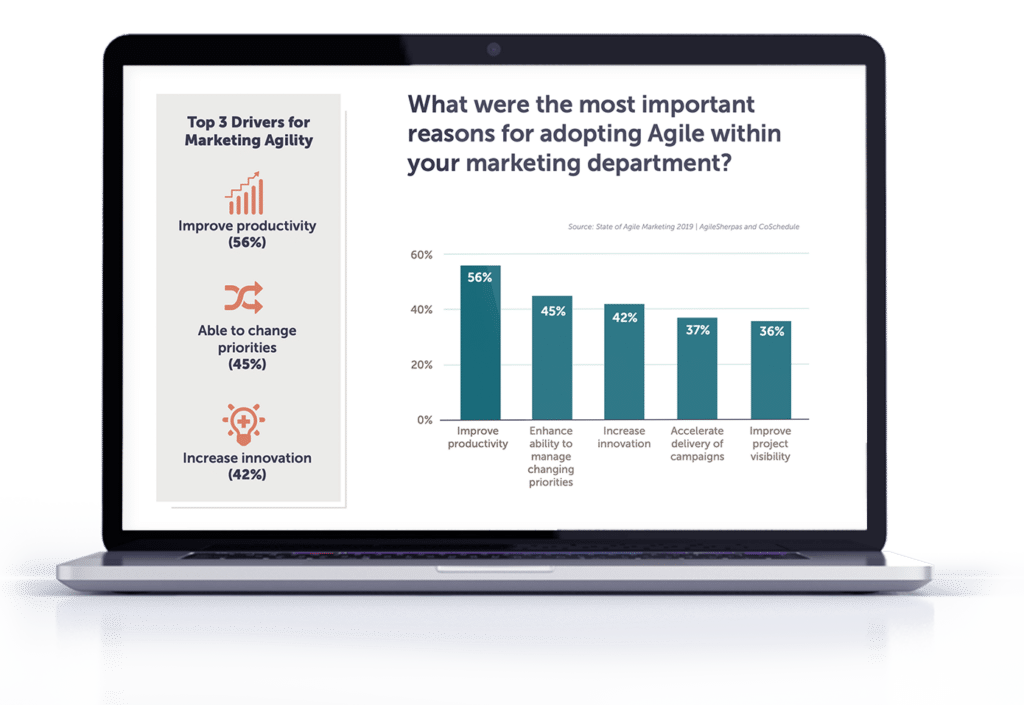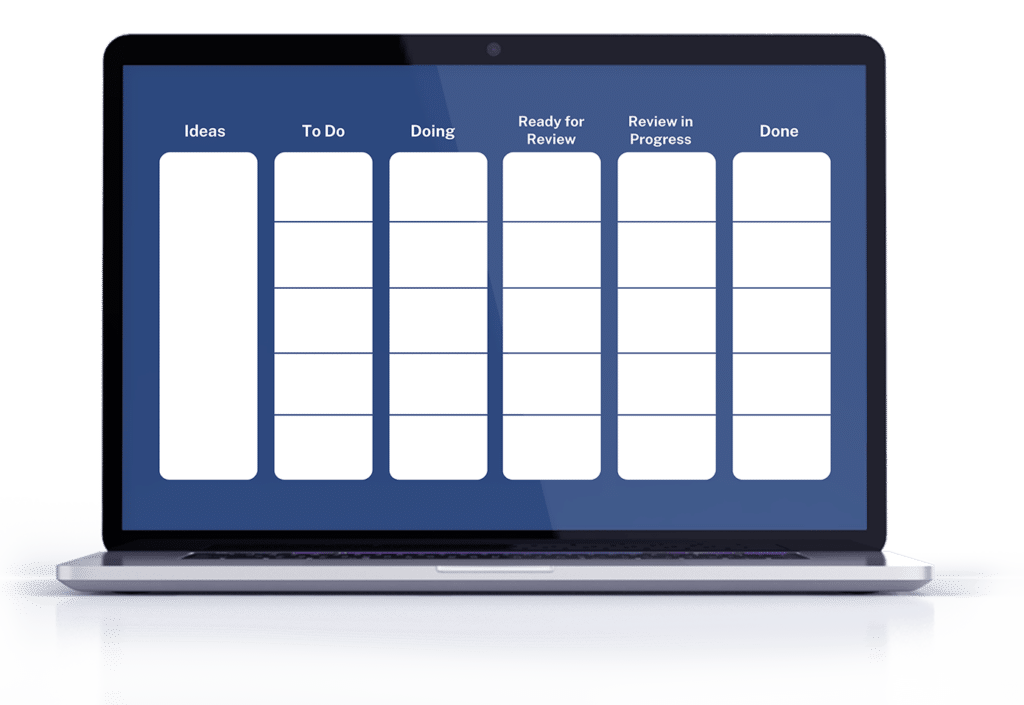
The buzz around Agile is continuously growing. Today, even some corporate giants are switching and opting to go Agile in hopes of boosting productivity levels. Ultimately, with the goal of acquiring and retaining more clients, law firms are also starting to jump on this bandwagon.
It is said that the teams that are going agile are 25% more productive. Moreover, 71% of US companies are now using Agile, and the number is expected to grow. While there are plenty of figures demonstrating the powerful benefits behind going Agile, there’s an apparent reason why some of the top fortune 500 businesses are already implementing this. Here’s a quick example of a giant that went Agile:
Cisco Systems, a multinational tech company, initially used the waterfall technique. This approach slowed the company’s development process, resulting in many problems, from quality issues to missed deliveries. In light of this, they opted for an Agile framework known as SAFe, the Scaled Agile Framework, and introduced agile training with their internal team. The results?
- Reducing defects by 40%
- Increasing efficiency by 14%
And that’s not all! Research shows that many industries, including the legal profession, adopt Agile for 5 main reasons. Check it out:
By now, you may be thinking, “So, what’s agile marketing? How can firms like mine go agile in this day and age?” You’re in the right place.
What is Legal Agile Marketing and Advertising & Why should Law firms care?
Bob, a multi-business owner, is in the market looking for an estate planning firm that’ll take care of his finances. He might have a few attorneys top of mind based on advertisements, billboards, networking events, etc. However, most seeking legal services consider this type of business a high-ticket purchase. Because of this nature, consumers like Bob will not only draw from their awareness; he’ll most likely confide in his close circles, such as family, friends, and colleagues. It doesn’t end here. Besides that, he’s most likely also actively checking review sites like Avvo and more.
Eventually, Bob will have a list of potential estate planning firms, and he’ll start narrowing down that list. Once he has his top choices, he might keep digging to find out more. At last, the ideal dream would be him booking a call with your firm. Nonetheless, it’s clear to see the process is not linear anymore.
In today’s marketing, this convoluted process challenges today’s firms who are trying to identify a clear path of purchase. The one-way customer journey as we once knew it isn’t a linear, direct process anymore. To give you an idea, the traditional funnel looks like this:

All customers going through the sales funnel should convert this way in a perfect world. However, we need to reiterate that today many customers are like Bob and their purchase process is unique and non-linear. They may go back and forth between different stages. So, what does this mean for law firms? Is this a bad thing? Far from it!
We’ll explain this new underlying phenomenon and new opportunities you can venture toward. Let’s begin.
Everything You Need to Know About the Dark Side of the Digital marketing Funnel

It indeed sounds like a concept straight out of the dark side of the force of Star Wars, but this concept was coined back in 2016. We’ll use a small science lesson to help explain the name and the concept of the dark funnel.
Dark matter is invisible and emits no light, yet it makes up over 80% of all matter in the universe. Amazing, isn’t it? There’s a similar theory in marketing, and it’s called the dark funnel.
Understanding today’s customers’ touchpoints
The dark funnel refers to the often hidden yet critical insights many miss when trying to understand the customer journey. It’s the untapped source of hidden and powerful knowledge you can leverage in your marketing. Think of the dark funnel as tapping into uncharted territory, the same way NASA and other aeronautics explore the great mystery of space.
Marketing is a highly-complex service, and the work between capturing a lead, nurturing it, and turning it into an actual case is far-stretched but not impossible, as we’ve seen in the profitable success many firms have with us.
However, can only one channel take all the credit for a firm’s success? Actually, on average, it can take around 8 different touchpoints to engage a user. For this reason alone, the most successful firms today are trying to be everywhere, digitally speaking. We continue to witness this first-hand, case after case.
Perhaps the most significant advantage of tapping into the dark funnel is hitting the mark with clients like Bob. It may seem like you’re blind to understanding the consumer’s behavior when most users today are constantly jumping back and forth in the messy middle, but there’s good news. Customers leave a kind of ‘breadcrumb trail’ across the internet, and you can make the most of it too.
To follow the breadcrumb trail, it’s best to combine data and a thorough understanding of your consumer’s behavior. These are also some of the promises behind the dark funnel, and here are 3 of the main ones:
- It helps you understand why people come to your website, read your blogs, watch your videos, listen to your podcasts, etc.
- It helps you define why you should do something and what to do.
- It helps you understand how things change over time and thus, helps you adapt and evolve.
Now that we’ve talked about a critical piece you shouldn’t miss out on, let’s talk about how you can pull the data “into the light.”
Improving your firm’s chances of being top of mind
Nobody decides to wake up in the morning and call a law firm, but you’ll want to be there when the time comes and they do. Prospects contact a firm once they require legal services, but that shouldn’t stop firms from creating an association and relationship beforehand. This is what is known as brand recall.
Making the most of the digital advertising budget
Firms investing, or looking to invest, in digital advertising services can benefit the most from our marketing Agile management. Why? The top benefit of Agile is better management of changing priorities and projects. Due to the dynamic and complex nature of digital advertising, this is a match made in heaven.
In fact, the latest tech report by AgileSherpas finds that Agile management is being adopted primarily for social media efforts.
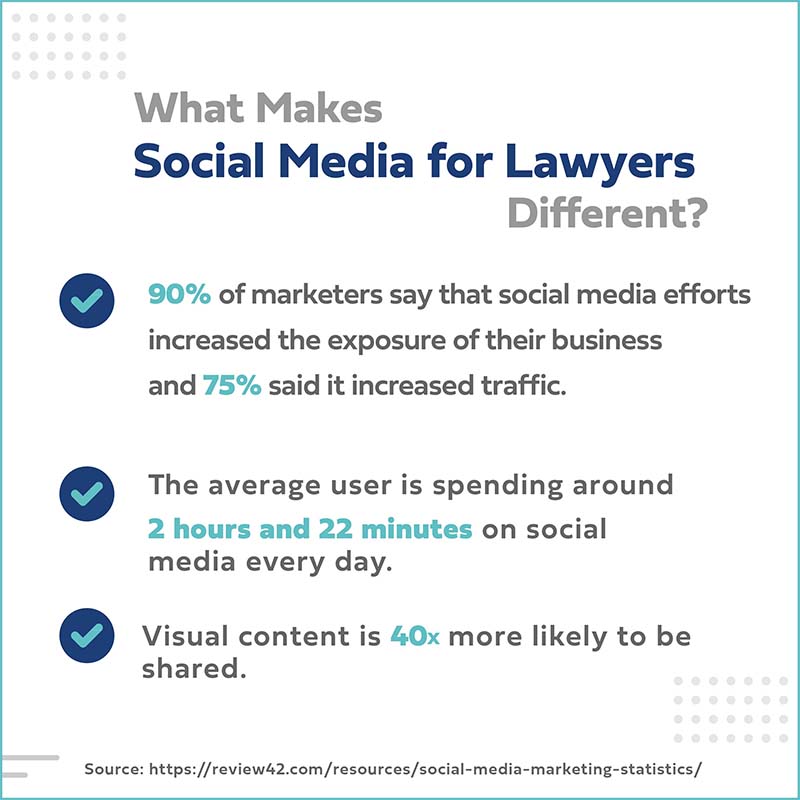
With Agile management in place, Consultwebs can swiftly relocate a firm’s digital advertising budget accordingly. The adoption of Agile is helping businesses dynamically reallocate their budget on an ongoing basis:
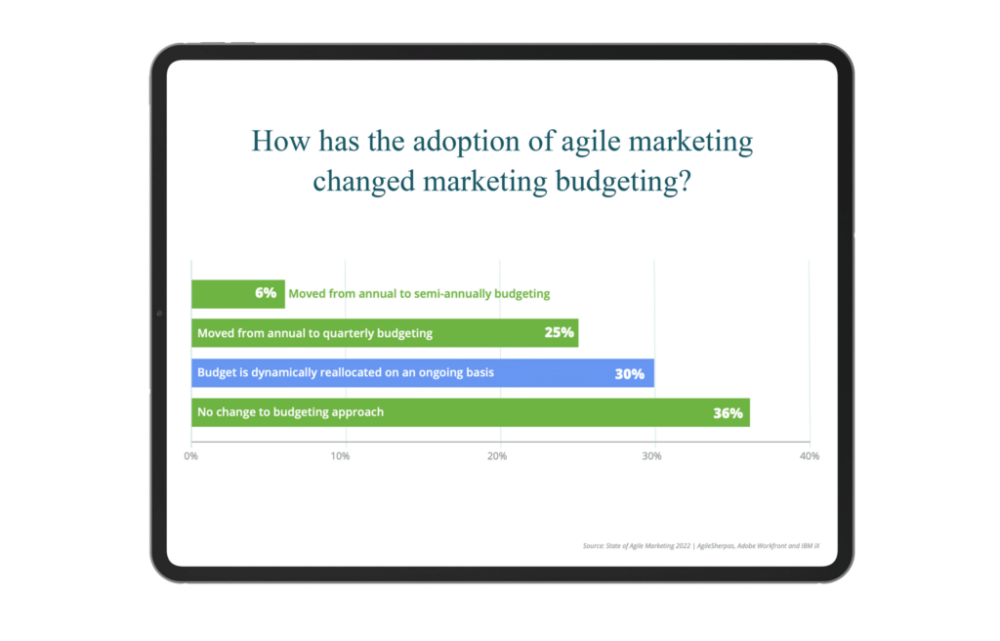
An Example of How Agile Marketing Works With Consultwebs:
- If data suggests costs are increasing on Facebook during the holiday season, we would have limited options when making Facebook campaign alterations or turning it off before Agile.
- Now, Agile allows us to use those funds on other platforms like Google Ads, LSAs, Digital Audio, etc. Here, clients can still get consistent results while Facebook runs at a higher cost.
Moving Faster Without Compromising Quality With Agile Marketing

In 2012 a group of forward thinkers met to create a guide pertaining to the future of modern marketing. This event was known as Spring Zero, a two-day gathering where many provided their take on digital marketing’s future. This led to the question, “Which method is ‘the best?” With that question in mind, Agile Marketing was born.
Agile Marketing is an approach based on the principles of agile methodology. These are the 5 principles in agile marketing:
- Adapt to change: Your firm’s business is dynamic by nature; therefore, it’s best to modify your plan of action from time to time.
- Experiment and test: To find out what’s working and what isn’t it’s critical to have organized controlled experiments.
- Quick iterations: A/B test with small changes in your marketing and re-run the modified strategies.
- Frequent interactions and feedback: For anyone in business, law firms included, feedback is necessary to grow.
- Constant learning and improvement: If you want to grow your firm, you’ll need to tweak your legal marketing.
The objective behind agile marketing is to manage all projects related to legal marketing. In other words, moving faster without compromising the quality of the deliverables.
How firms can implement Agile Marketing:
- Sprints – A sprint refers to the timeframe you’re giving your team to complete the current projects. This isn’t set in stone, but sprints typically last between 2-6 weeks. More significant projects might not fit into this timeframe. Therefore you can break the projects into pieces.
- Stand-up meetings – AKA a daily scrum is a short daily meeting where your team gets together to check-in. Each member goes over what they did, goals for the team, roadblocks, etc.
- A board to track your firm’s progress – It’s your choice whether you prefer sticky notes or a digital Kanban board. As long as you have a central way of tracking your sprint efforts.
- Teamwork – This is the most critical element. Everyone in your team should be prepared to collaborate and assist.
Measuring your Firm’s Agile Marketing Strategy

“How do I know agile marketing is effective for my firm?” This is perhaps the most crucial question of them all. Here’s the metric in agile marketing: brand recall.
Brand recall correlates to your revenue. However, measuring direct-cause-and-effect is tricky because there isn’t a single-touch attribution. Today’s marketing focuses on being all around the conversion path to reach your audience at different stages. When your ads appear on a user’s screen, that’s an impression. This is important because before you get any user to click and convert, you need to know if you’re commanding their attention.
You want to give users that ‘aha’ moment when they see you, and this is where brand recall comes in. It helps you answer questions like:
- Did users see the ad?
- Did users engage with it?
- Did it make an impact on the viewer?
Learn more about how conversion attribution works and find out how you should best attribute YOUR firm’s conversions by downloading the resource below.
Why Consultwebs has Adopted Agile Management
We understand digital marketing services are dynamic and highly complex, and to meet today’s demands, Consultwebs was the first legal marketing agency to adopt Agile.
Firms want to navigate challenges and venture into new opportunities, which is precisely what Consultwebs is helping firms accomplish. AgileSherpas, the world’s leading Agile training, found that more B2B and B2B industries are moving from traditional waterfall techniques to Agile. Take a look:
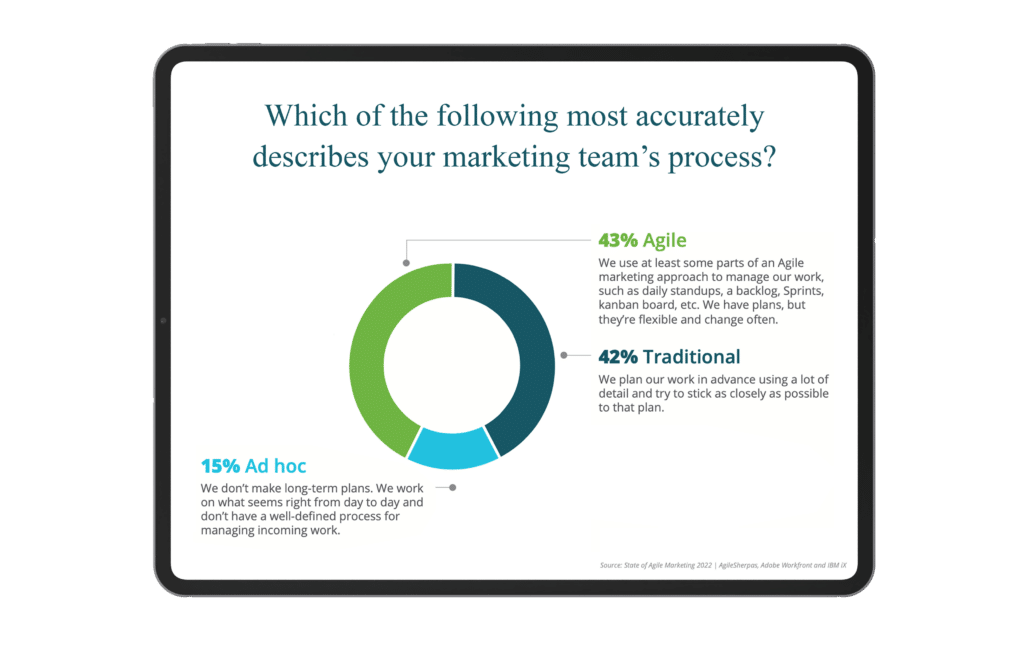
Planning for the Unplanned Road Ahead
Investing in organizational agility doesn’t mean problems won’t arise. However, challenges like last-minute requests, lack of consistency in work, and poor effectiveness are handled better than in traditional teams.
All firms investing marketing dollars need a team that is:
- Aligning with your goals, especially long-term ones.
- Maximizing the customer experience.
- Moving the needle.
Before diving in, you’ll want to know: “How Agile is my firm’s marketing?”
Find Out How Agile Your Firm is With this FREE analysis.
Whether you want to plan for the unplanned road ahead, ask more questions, see Agile management in action, or more, we’re here to help.
Top FAQs For Law Firms Going Agile
1. What exactly is Agile for law firms?
Agile is all about adapting to evolve and thrive in today’s highly dynamic, complex, and competitive business world – especially for those in the legal profession. By definition, Agile is “the ability to create and respond to change. It is a way of dealing with, and ultimately succeeding in, an uncertain and turbulent environment.”
This brings us to the next question…
2. What’s the difference between Agile and Waterfall?
Most involved in the marketing, advertising, and business process are familiar with the good old Waterfall technique. It involves the creation of monthly, quarterly, and yearly plans combined with a series of launches throughout the year. While it’s pretty straightforward, in today’s highly dynamic world, it may be challenging to foresee the market 6 or even 12 months from now, and this is where Agile comes in.
Agile focuses on shorter sprints and shorter campaigns that reflect current market conditions. Unlike waterfall’s rigid structure, Agile focuses on the ability to pivot to thrive in today’s dynamic environment.
3. What are the main characteristics of a legal Agile team?
Whether you’re looking to implement this internally or with your legal marketing agency, there are 4 main characteristics of an Agile team:
- Teamwork and collaboration
- Working with more collaboration across teams, ensuring everyone contributes ideas. The more, the merrier.
- Data-driven decision making
- Data in today’s world is one of the most valuable assets, and decisions driven by data are worth their weight in gold!
- Rapid and iterative releases
- To regularly adapt and adjust to your firm’s current needs, it’s best to work in short sprints that allow room for improvement as you go.
- Adherence to the agile marketing manifesto
- Last but not least, the team should stick to the Agile Marketing Manifesto. If you want to know the history behind the Manifesto and its 4 values, check out this short explanatory video:
4. “Can you name a few benefits my law firm can expect from going Agile?”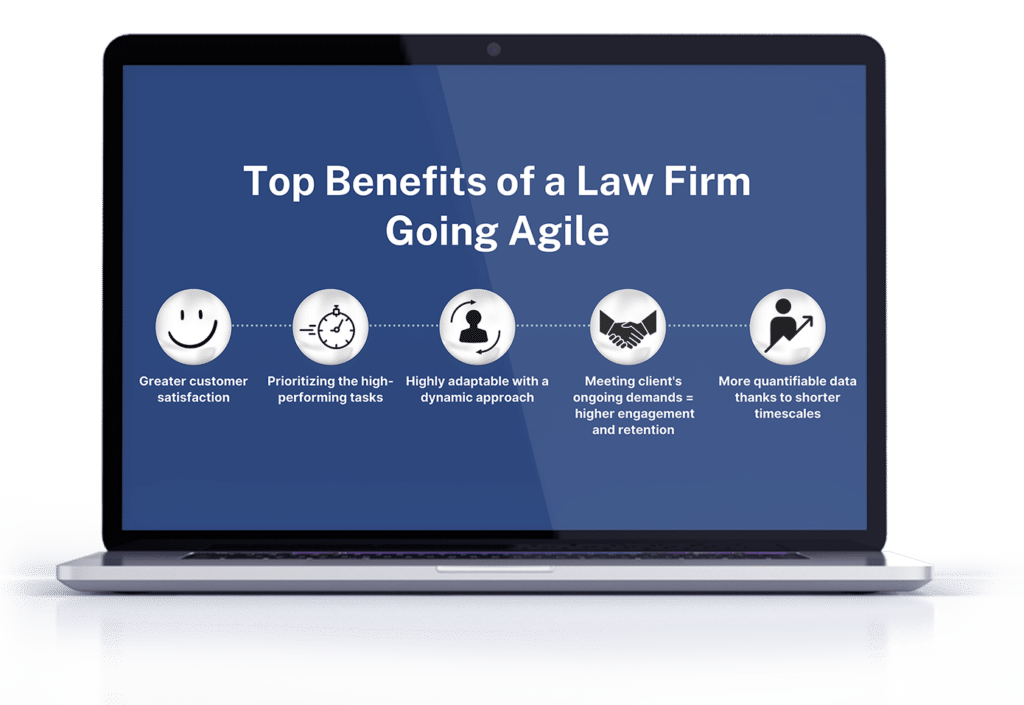
5. “What are some of the top Agile techniques my law firm can implement?”
- Sprints – A sprint refers to the timeframe you’re giving your team to complete the current projects. This isn’t set in stone, but sprints typically last between 2-6 weeks. More significant projects might not fit into this timeframe. Therefore you can break the tasks into pieces.
- Stand-up meetings – AKA a daily scrum, this is a short daily meeting where your team gets together to check in. Each member goes over what they did, goals for the team, roadblocks, etc.
- Teamwork – Everyone in your team should be prepared to collaborate and assist.
- A board to track your firm’s progress – It’s your choice whether you prefer sticky notes or a digital Kanban board. The point is to have a central tracking record of your sprint efforts.
Want a FREE Kanban template? We’ve created one for you!
Want to try it? Download by clicking on the image above, print a copy and put sticky notes in the categories!
6. “Let’s say I want to implement a Kanban board. How do I define the ‘In Review’ section?”
The previous Kanban board offers a general birdseye view of how your team’s workflow works with Agile, but Kanbans can be 100% adjustable according to your firm’s process. Usually, it begins with an idea and follows through with the to-do and doing, but confusion may arise under the ‘review’ stage.
A basic Kanban board would typically stick to one ‘review’ section, but you can break it down into multiple sections. For example:
- Ready for review: The work is done, and the person in charge of reviewing needs to go over the task.
- Review in progress: The person in charge of reviewing is already going through the task.
- Waiting on 3rd party: The work is done, except the team is waiting on an external party to check it.
7. “Does daily stand-up really help my team? I feel a sprint is enough. What added value do daily stand-ups offer?”
We’ve discussed some Agile techniques, two of them being sprints and stand-up meetings. Firms looking to go agile should incorporate both. Here’s why.
Things move fast; a week from now, your team might have different priorities, and going an entire week without checking in on your teammate’s progress introduces a high level of risk. This is one of the main reasons many businesses are going Agile; they want to be able to switch gears rapidly without compromising team communication and quality work.
8. “How do I get my team on board with real agility vs last-minute pivots?”
Frequent last-minute changes impact a team’s staff and clientele in more ways than one might expect. If we were to revisit the case of Cisco Systems, the waterfall technique with strict timelines and “last-minute pivots” impacted the company’s delivery and bottom line.
On the contrary, real agility relying on sustainable techniques like stand-up meetings, sprint projects, and cross-functional team collaboration helps build “moldable guardrails” around the team. Because Agile focuses on shorter periods, it allows the team to focus on what’s essential now while keeping an open mind to any future changes.
Eventually, All Roads Should Lead To…
Your clients!
One of the most potent underlying benefits of Agile is the ability to remain consistent with your success, your team, and, most importantly, your clients. In the business of law, consistency beats predictability. Most people prefer to avoid the unknown, and if a client knows a firm can consistently deliver the same level of service, they will be comfortable because they know what to expect from you.
Learn more about how conversion attribution works and find out how you should best attribute YOUR firm’s conversions by downloading the resource below.
